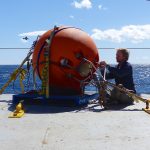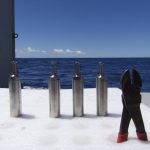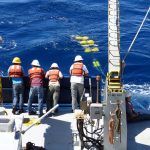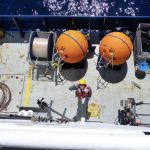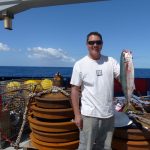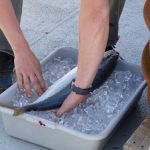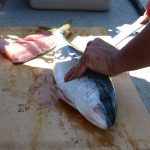We took advantage of a sunny, temperate weather window on Sunday to deploy moorings T1 and T3. We loaded each of the moorings with 36 temperature sensors, which spanned half a kilometer of line, and three CTD’s, instruments that use a band of sensors to measure the water’s conductivity, temperature and density. For each of the moorings we’ve deployed so far, we have fashioned them with a satellite beacon and a strobe light to the top of the line so that we can easily detect them when we pick them up in March. We’ll have about 12 days to recover all of our moorings on the last leg of the cruise, and if the weather is as unpredictable as it has been the past few days, we may have to prepare to pull them out at different times of the day.
After the first mooring, Paul Chua spotted about a dozen southern yellowtail swimming around the back of the ship. He grabbed his fishing pole and within minutes snagged a nice little five-pounder, a rarity in these southern waters. He and Harper Simmons carved out a chunk of sashimi to enjoy on the deck while the rest of us took advantage of a few moments of sunshine. Our head cook, Jay Erickson, threw the yellowtail on the grill and we all enjoyed a bite with our Sunday steak dinner. Delicious!
—Julia Calderone, The Revelle
- Sam Fletcher prepares the top float of mooring T1. Credit: Julia Calderone.
- A line of temperature sensors; ready to be taped to the mooring line. Credit: Julia Calderone.
- Gunnar Voet, Matthew Alford, Sam Fletcher, Paul Chua and Eric Boget watch the anchor of mooring T1 drop. Credit: Julia Calderone.
- Bob Hallberg returns his gear after a successful mooring. Credit: Julia Calderone.
- Paul Chua and his catch, a five pound southern yellowtail. Credit: Julia Calderone.
- Our dinner. Credit: Julia Calderone.
- Paul Chua filets his yellowtail on the deck of the boat. Credit: Julia Calderone.
- Who wants sashimi? Credit: Julia Calderone.
The Tasman Tidal Dissipation Experiment//Supported by the National Science Foundation

